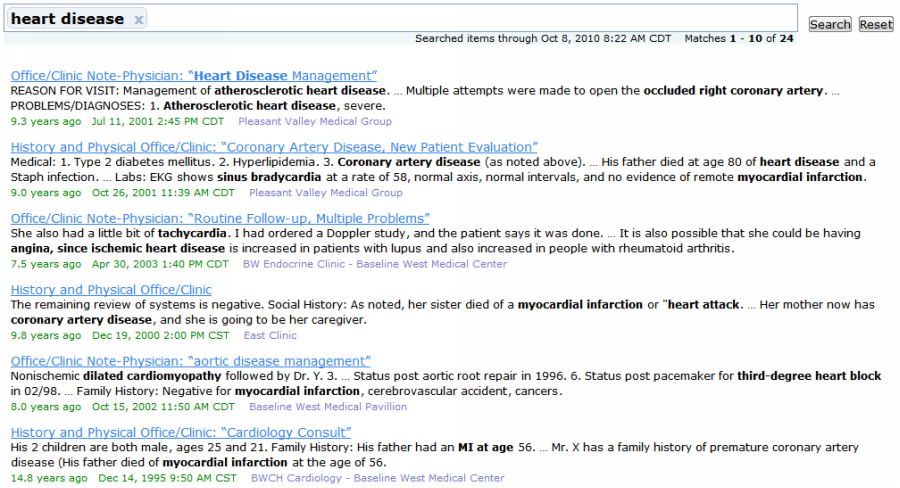Cerner Corporation is a supplier of healthcare information technology solutions, services, devices and hardware. Cerner solutions optimize processes for healthcare organizations. These solutions are licensed by approximately 9,300 facilities globally, including more than 2,650 hospitals; 3,750 physician practices 40,000 physicians; 500 ambulatory facilities, such as laboratories, ambulatory centers, cardiac facilities, radiology clinics and surgery centers; 800 home health facilities; 40 employer sites and 1,600 retail pharmacies. The Company operates in two segments: domestic and global. The domestic segment includes revenue contributions and expenditures associated with business activity in the United States. The global segment includes revenue contributions and expenditures linked to business activity in Argentina, Aruba, Australia, Austria, Canada, Cayman Islands, Chile, China (Hong Kong), Egypt, England, France, Germany, Guam, India, Ireland, Italy, Japan, Malaysia, Morocco, Puerto Rico, Qatar, Saudi Arabia, Singapore, Spain, Sweden, Switzerland and the United Arab Emirates.
For more information please visit https://www.cerner.com/. |
Cerner Corporation's Millennium healthcare system manages terminologies, classifications and other code systems within a terminology service - the Cerner Millennium Terminology (CMT) package. CMT accommodates and integrates SNOMED CT International Release data and National extension content - such as concepts, relationships, descriptions, subsets, maps etc.
At the Cerner Millennium user interface, content can be captured at point of care as SNOMED CT codes. Modules used with SNOMED CT include: Problems and Diagnoses, Allergies, Procedures, Pharmacy Orders, Radiology Orders and Cellular Pathology Reports.
Either Cerner or third party clinical encoding software can process SNOMED CT Diagnoses and Procedures captured in Millennium and suggest ICD-10 and other classification codes to Clinical Coders for activity reporting and billing.
SNOMED CT is also used extensively behind the scenes to support more sophisticated analytic facilities within their Natural Language Processing (NLP) tools and reporting tools. These Cerner products and services exploit unique features and content of SNOMED CT to extend the power of these applications.
The Cerner product suite includes two data warehousing applications. These applications share much of their terminology-related technology, including supporting subsumption queries with the CMT Concept Explode/Transitive Closure facility, which utilizes the SNOMED 'is a' relationships.
The PowerInsight® Data Warehouse (PIDW) is an enterprise level data warehouse which updates on a nightly basis from the live electronic patient record. PIDW services standard operational reporting, mandatory reports (e.g. for National or State governments and regulatory bodies), and ad hoc queries e.g. individual lists of patients treated as requested by clinicians for audit.
The Health Facts® Reporting supports the pooling of anonymized data from different healthcare organizations. Health Facts data warehouse represents information of electronic records from millions of inpatient, emergency department, and outpatient visits from participating U.S. health care organizations. (Data are encrypted and secured to ensure patient confidentiality in compliance with HIPAA privacy regulations.) The reporting facilities enable the analysis of patient care and process trends within a facility and provide comparisons to other Health Facts contributors.
The Cerner data warehouse query tools include simple graphical user interfaces which directly create powerful reports using the SNOMED CT hierarchy content. The screenshot below in shows a report of attendances with diagnoses which are a descendent of the SNOMED CT concept
.

Report produced by Cerner's data warehouse query tool |
Other Applications
Cerner's Natural Language Processing (NLP) technology interprets the content of clinical notes through a complex understanding of grammar, syntax, synonymy and phraseology. SNOMED CT's semantic content and concept model enriches the analysis of the text in several ways including
Computer Assisted Coding allows the extraction of appropriate SNOMED CT codes for automating coding and billing processes.
Chart Search/Semantic Search is a tool that enables clinicians at the point of care to search in real time through a patient's multiple charts, pathology reports and other documents, for topics such as 'heart disease' and 'diabetes'. The interface, as shown below in has the look and feel of a World Wide Web search engine.

User interface of Cerner's Chart Search/Semantic tool |
The searches can be filtered by date, document type etc. However the power of this approach is extended beyond conventional search engine indexing by using SNOMED CT. Cerner's tools index SNOMED CT findings (including diseases and symptoms) and procedures to make searches and queries over these domains faster. Cerner also hand curates exceptions and associations between related concepts. A Clinical Significance Score is assigned to each concept to allow documents to be sorted based on the probable relevance of the concepts in the document given their context of use.
As shown in for example, when given the search term 'heart disease', the 'is a' hierarchies of SNOMED CT enable recognition and return of documents which reference 'sinus bradycardia' and 'dilated cardiomyopathy'.

Search results from Cerner's Chart Search tool |